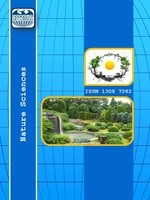ERGANİ-ÇERMİK (DİYARBAKIR) ARASINDAKİ KENAR KIVRIMLARI KUŞAĞI VE ÇEVRESİNİN JEOMORFOLOJİK ÖZELLİKLERİ
Ergani-Çermik arasında kalan saha ve çevresi Türkiye'nin en genç tektonik birliklerinden olan kenar kıvrımları üzerinde olması açısından önemlidir. Çevredeki jeomorfolojik oluşumlar oldukça gençtir. Yerşekilleri, bilinenin aksine erime süreçlerinden çok tektonik, fluviyal ve volkanik süreçlerin etkisinde gelişmiştir. Ergani kuzeybatısındaki Sallar çevresi boşaltılmış bir depresyon (antiklinal) Ergani ovası ise birikim havzasıdır. Çüngüş-Lice hattı boyunca uzanan ters fay oldukça genç olup sahanın jeomorfolojik birimlerinin oluşmasında önemli rol oynamıştır. Daha önce Ergani ovasından akan Maden çayının Güneydoğu Anadolu yükselimiyle yatak değiştirmesi sonucu fluviyal süreç kesintiye uğramıştır. Birçoğu eski alüvyal dolgular üzerine kurulmuş tarih öncesi yerleşmeler ile bu eski akarsu mecrası arasında yakın ilişkiler mevcuttur.
Anahtar Kelimeler:
Ergani Ovası, Çermik Antiklinali, Sallar Depresyonu, Maden Çayı, Güneydoğu Kenar Kıvrımları,
THE GEOMORPHOLOGICAL FEATURES OF THAT FOLDED BELT OF AND SURROUNDINGS BEETWEN ERGANI-ÇERMIK(DIYARBAKIR)
The plain and surroundings between Ergani beetwen and Çermik plain and its surrounding are important for the reason that it is on the bends of the newest tectonic units in Turkey. Geomorphologic creations on the surrounding are rather new. Geography was formed by tectonic pluvial and volcanic process, not by dissolving as most widely known. Sallar and surroundings on the North West of Ergani are a discharged depression (anticlinal, and Ergani Basin is an accumulation basin. Reverse fault lying along Çüngüş-Lice Line is rather new, and played an important role in the formation of the area. Pluvial process is cut when the Maden Creek which was running on Ergani Plain changed its channel with the ascension of the South-East Anatolia. Pre-historical settlements which were located on these old alluvial fillings must have close relationship with this old river channel.
Keywords:
Ergani Plain, Çermik Anticlinal, Folded Belt of the Southhern Part of Anatolia, Maden Creek, Sallar Depression, ,
- Başlangıç: 2009
- Yayıncı: E-Journal of New World Sciences Academy
Sayıdaki Diğer Makaleler
GÜNEYDOĞU ANADOLU BÖLGESİNDE 31 EKİM-1 KASIM 2006 TARİHLERİNDE MEYDANA GELEN TAŞKINLARIN ANALİZİ
ANKARA'NIN KENTSEL GELİŞİMİNİN UZAKTAN ALGILAMA VE COĞRAFİ BİLGİ SİSTEMLERİYLE ÖLÇÜLMESİ
ANZER-KEMER-ORSOR DAĞLARI KUZEYİNİN (RİZE) GLASYAL MORFOLOJİSİ
